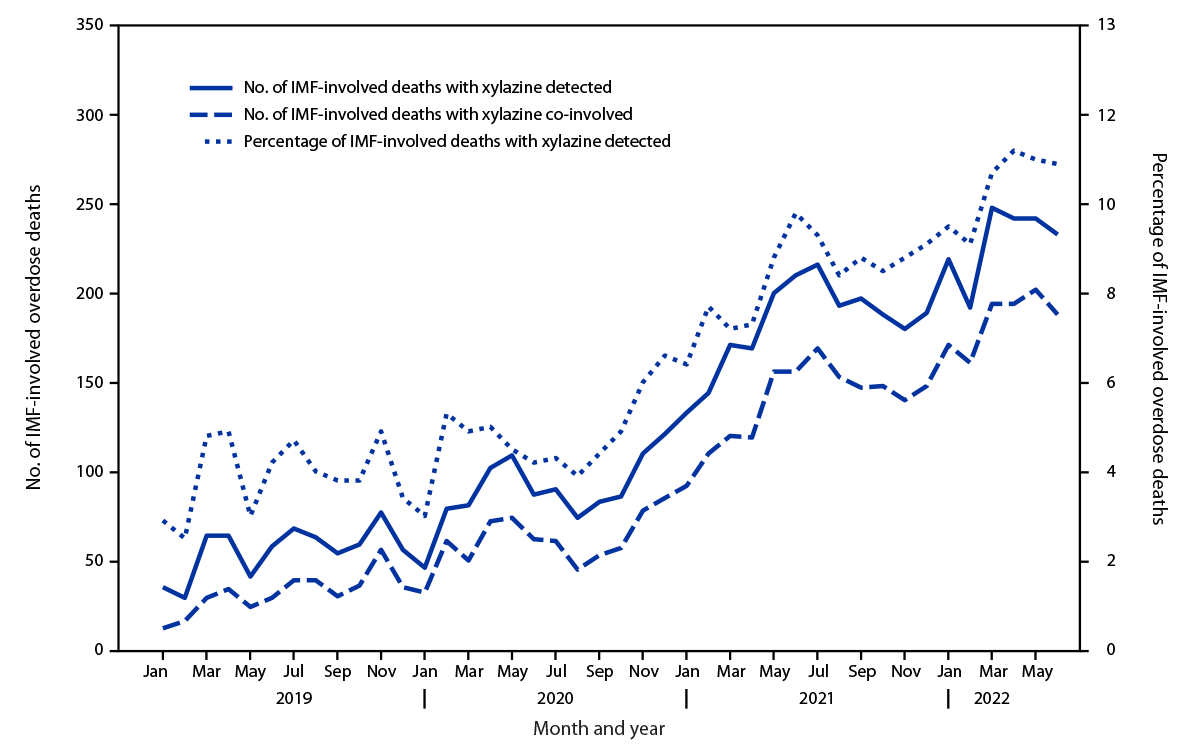The Effects of Xylazine: What We Know So Far
Xylazine has been in the news over the past few months and has currently been reported in 48 states throughout the United States. Xylazine is a non-opioid tranquilizer used in veterinary medicine and has been linked to an increasing number of overdose deaths. Commonly, xylazine adulteration (or ‘lacing’ of xylazine into drugs) is linked with illicitly made fentanyl (IMF). Bee the Vibe wrote a blog previously about the basics of xylazine, but the reason why xylazine is becoming more common is because it is used to enhance drug effects and/or increase street value by weight.
The problem is, it can be very dangerous when paired with IMF or other drugs. Since xylazine is a veterinary tranquilizer, its effects have not been studied on the human body. A new CDC report shows that there has been a 276% increase in xylazine in opioid-related overdoses. Moreover, these overdose rates disproportionately affect marginalized communities like BIPOC and Latinx communities.
Kariisa M, O’Donnell J, Kumar S, Mattson CL, Goldberger BA. Illicitly Manufactured Fentanyl–Involved Overdose Deaths with Detected Xylazine — United States, January 2019–June 2022. MMWR Morb Mortal Wkly Rep 2023;72:721–727. DOI: http://dx.doi.org/10.15585/mmwr.mm7226a4
In general, there’s broad harm reduction strategies that can help protect against opioid overdoses like:
Testing substances for fentanyl (and now testing opioids for xylazine).
Carrying naloxone (the lifesaving overdose reversal tool)
Never using alone (and if you are, using the Never Use Alone Hotline: 800-484-3731)
Using less of a substance and going ‘slower’ with progression of it.
But as xylazine has become more of an emerging issue, researchers have set out to understand more about why xylazine may be impacting overdose death rates. A study published in June 2023 had several conclusions after analyzing the effect of xylazine and xylazine-fentanyl doses in rats, including:
Even with low doses of xylazine, researchers observed known effects of the drug including sedation, muscle relaxation and decreased body temperature.
When xylazine was mixed with fentanyl or heroin, the rats didn’t have a quick rebound of oxygen levels like they normally would if it was fentanyl or heroin alone. This means that there was less oxygen in the brain for a longer period of time, which can be very dangerous and cause more harm during an opioid overdose.
These findings suggest the way in which xylazine impacts opioid-related overdoses by decreasing oxygen levels in the brain and blood. Specifically, the addition of xylazine to fentanyl or heroin disrupts the important mechanism that the brain uses to counteract a rapid loss of oxygen after being exposed to opioid drugs. Therefore, xylazine may be seriously contributing to overdose deaths involving opioids.
As we learn more about xylazine, Bee the Vibe will continue to provide updates and information for the community. Although xylazine is a non-opioid, we recommend always administering naloxone when you suspect someone is experiencing an overdose and alerting EMS services. In Colorado, there are Good Samaritan laws that protect you; so, you should always call for help. By carrying naloxone, and employing different strategies mentioned earlier, you can reduce the risk of harm for both you and your community.
Need to get naloxone, fentanyl test strips or xylazine test strips? Bee the Vibe offers all of those resources, and more, for free. Visit beethevibe.org to make an appointment, today!
References:
Choi, S., Irwin, M.R. & Kiyatkin, E.A. Xylazine effects on opioid-induced brain hypoxia. Psychopharmacology 240, 1561–1571 (2023). https://doi.org/10.1007/s00213-023-06390-y
Kariisa M, O’Donnell J, Kumar S, Mattson CL, Goldberger BA. Illicitly Manufactured Fentanyl–Involved Overdose Deaths with Detected Xylazine — United States, January 2019–June 2022. MMWR Morb Mortal Wkly Rep 2023;72:721–727. DOI: http://dx.doi.org/10.15585/mmwr.mm7226a4

